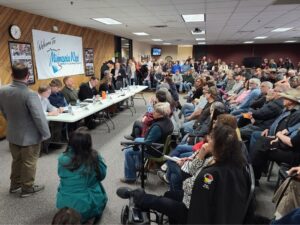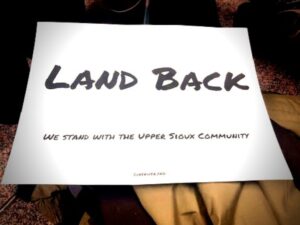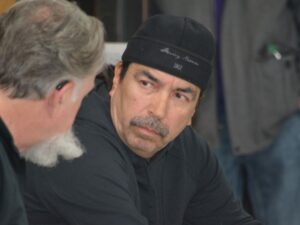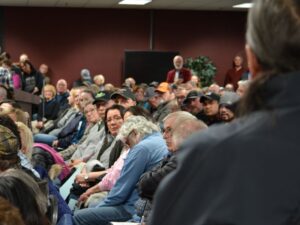Minnesotans from around the region traveled to Granite Falls to learn more about the proposed land transfer of Upper Sioux Agency State Park back to the Dakota people
Area residents encouraged to be on the “right side” of history moving forward
On the evening of Wednesday, April 5, several hundred people gathered in Granite Falls at the Minnesota West Campus to hear from officials the details of the proposed land transfer of the Upper Sioux Agency State Park (USASP) back to the Dakota people of the Pezihutazizi Oyate (Upper Sioux Community).

Rep. Chris Swedzinski and Sen. Gary Dahms organized the Town Hall Meeting to bring officials to share information with interested parties from around the region. On the panel was Chairman Kevin Jensvold, Upper Sioux Community (USC), Ann Pierce and Scott Roemhildt from the Minnesota Department of Natural Resources (DNR), David Kelliher and Ben Leonard from the Minnesota Historical Society (MHS), Dave Smiglewski, Granite Falls, Commissioner John Berends, Yellow Medicine County. Swedzinski and Dahms began the meeting with ground rules for behavior. They stated the purpose of the meeting was to bring information to the public.
The meeting began with the history of how the USASP land transfer started. Since the early 2000s, the Upper Sioux Community has requested to have the land returned due to the unusual circumstances and significance of this park for the Dakota people. For example, many in the Upper Sioux Community have ancestors buried on the USASP property and have had to pay to visit their relatives’ graves. The Upper Sioux Community brought this request to two previous Governors and now Governor Walz.
Over the past decade, USASP has suffered from various maintenance and funding issues. The park has gone from being open year-round to now only operating seasonally. The USASP interpretive center was condemned this past year due to ongoing disrepair. In 2019, the main road to the park, Minnesota state highway 67, was closed due to massive cracks, and the road was fully decommissioned in 2022 due to these fault line disruptions. The bridge over the Yellow Medicine River will be removed by 2026 due to ground movement. Collectively, these issues create a set of circumstances that significantly limit the public use of USASP, and significant decisions for its future were overdue.

As part of any DNR land transfer, land of equal value must be acquired as part of a proposed transfer. In the USASP land transfer, a new $5.3 million park must be acquired and made available for public access and recreation. At the public meeting, there was extensive discussion about ensuring the new acquisition would be as close as possible to the current location, have as many of the current amenities that USASP offers, and more. Once built, the operational budget would replace that of USASP. Generally, it is not an added financial burden on the DNR Park and Trail’s current budget.
The Upper Sioux Community met with Rep. Swedzinski some 16 months ago and asked him, as their Minnesota House Representative, to carry the bill to the legislature that supported the land transfer. Rep. Swedzinski declined. The Upper Sioux Community reported that they were unsuccessful in connecting with Sen. Dahms at that time. Instead, they turned to other Minnesota lawmakers who were interested in supporting their request. In the Minnesota House, Reps. Stephenson, Keeler, Hortman, Kozlowski, Frazier, and others co-sponsored a bill, and Sen. Kunesh authored a bill in the Senate, both of which are included in omnibus bills. These bills support the transfer of the USASP land back to the Upper Sioux Community. They also charge the DNR and MHS with coming up with what needs to be considered and addressed in the proposed transfer. Over the next ten months, they are being asked to map out what that public engagement process might look like and report back to the legislature.
At the meeting, Ann Pierce from the DNR pointed out that there are partners at the local, county, state, tribal, and federal levels who would be involved in this process. Pierce explained that funding is available for the proposed land transfer process through the Land and Water Conservation Fund administered by the National Park Service. This grant program provides resources to state parks for land transfers and acquisitions under the Department of the Interior.
Chairman Jensvold shared that it is a priority for the Tribe to support and find replacement acres for the new park as close to the area as possible. A delegation from the Tribe traveled to Washington, D.C., to meet with the National Park Service to ask for special consideration for an exception to the twelve-month timeline that the current acquisition program requires to provide extra time to secure land for the new park.
The USASP was established in 1963 on the ancestral lands of the Dakota people to preserve and interpret the remains of the old Agency site. Located on the Minnesota River near the confluence of the Yellow Medicine River, it has historically been a place where many Indigenous people have gathered medicines from the native plants that this ground holds. The park (1,280 acres) offers a unique mix of open prairie, bluffs, and wooded slopes.
Ben Leonard from MHS shared that in 1969, 19.3 acres that were considered to be the Upper Sioux Agency Historic site were put under the stewardship of MHS. In 1970, a new building was constructed that replicated the original structure and put on the original foundation. It is one of five sites held for preservation in Minnesota and is not advertised by MHS as open to the public.
The Treaty of Traverse Des Sioux of 1851 moved the Dakota Indians from Iowa and Minnesota to a reservation 20 miles wide along the Minnesota River Valley, extending from Big Stone Lake to Fort Ridgely. The Yellow Medicine Agency was established to administer the terms of the treaty. In the summer of 1862, the Yellow Medicine Agency was destroyed during the U.S. – Dakota War.

Chairman Jensvold commented, “Our history and how we refer to that place is one of genocide, and if we cannot, as a society today as human beings, look back and say that what occurred then, we are only prolonging this divisiveness that occurs as part of our history.”
When asked what the plan for the space is by the Tribe if the transfer goes through, Chairman Jensvold responded, “Moving forward, this land will be treated in a respectful and solemn manner for all people to remember what occurred here and to make sure it is memorialized accurately and make sure it is treated respectfully because we truly don’t agree with the term recreation as it applies to this land and that is one of our biggest difficulties we have as Dakota people.”
He continued, “Not long ago, I testified in the House, and I said, ‘I want to leave you with a picture…. in the same place that people are there having a Sunday picnic, smiling, and having a wonderful time – that is the same place our ancestors were starved to death, with children and old people ultimately dying. In that place – so if you could accept that as something you can relate to, you’ll see why it shouldn’t be a place of recreation, but a place of reverence.”

Takeaways of the night –
- The grounds of the USASP is the resting place for the ancestors of the Dakota people. Should we be camping, picnicking, hiking, riding horses, etc., in this sacred place?
- The Dakota people have been in this river valley for thousands of years and long before the introduction of settlers to the area.
- The Dakota people had their land stripped away without compensation, and many of us living in the ceded territory of the river valley are beneficiaries of that horrific time in history.
- The 1,280 acres that the Upper Sioux Community is asking for is less than 1% of what their people originally lived on.
- For Minnesotans concerned about not having a place to ‘recreate,’ the proposal is to replace the current acres with a new $5.3 million park in a new location as close to the area as possible.
- We must be reminded that all people living within the state’s boundaries are Minnesotans.
- Misinformation about this issue is rampant.